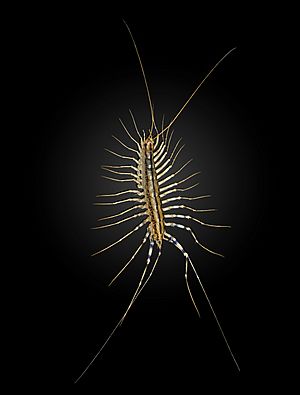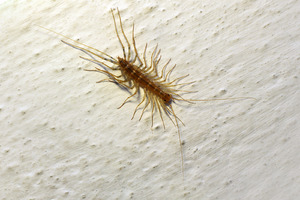House centipede facts for kids
Quick facts for kids House centipede |
|
|---|---|
 |
|
| Scientific classification | |
| Kingdom: | |
| Phylum: | |
| Class: | |
| Order: |
Scutigeromorpha
|
| Family: |
Scutigeridae
|
| Genus: |
Scutigera
|
| Species: |
S. coleoptrata
|
| Binomial name | |
| Scutigera coleoptrata |
|
Scutigera coleoptrata, often called the House centipede, is a yellowish-grey centipede with up to 15 pairs of legs. These creatures are found all over the world. They often live inside human houses and apartments. The house centipede is an insectivore, meaning it hunts and eats spiders and other insects. They were first described way back in 1758. House centipedes are harmless to humans, even though their fast movements might sometimes make people jump!
Contents
- What Does a House Centipede Look Like?
- Reproduction and Life Cycle
- How House Centipedes Behave
- Where House Centipedes Live
- Where House Centipedes Are Found
- House Centipedes and Humans
- Australian House Centipede: What It Looks Like
- Where the Australian House Centipede Lives
- Australian House Centipede Behavior
What Does a House Centipede Look Like?
An adult house centipede's body is about 1 to 1.4 inches (25 to 35 mm) long. It has up to 15 pairs of long legs attached to its body. With its long antennae, the centipede can look much longer, sometimes up to 3 to 4 inches (75 to 100 mm).
These delicate legs help it move super fast, up to 1.3 feet per second (0.4 m/s)! They can run across floors, up walls, and even along ceilings. Their body is yellowish-grey and has three dark stripes running down its back. The legs also have dark stripes. House centipedes have a cool trick called automimicry. Their back legs look like antennae, making it hard to tell which end is which when they are resting.
Unlike most other centipedes, house centipedes have special eyes that are made of many tiny parts, like a fly's eye.
Reproduction and Life Cycle
House centipedes usually lay their eggs in the spring. In one study, a female centipede laid an average of 63 eggs, and sometimes up to 151 eggs! When young centipedes hatch, they look like tiny versions of the adults, but with fewer legs.
Baby centipedes start with four pairs of legs. They gain more legs as they grow and molt (shed their skin). They get one new pair of legs after their first molt. Then, they get two new pairs of legs with each of their next five molts. Adult centipedes have 15 pairs of legs and keep that number through several more molting stages. House centipedes can live for three to seven years, depending on where they live. They can start having babies when they are about three years old.
When it's time to mate, the male and female centipedes circle each other. They touch each other with their antennae. The male then leaves his sperm on the ground, and the female picks it up to fertilize her eggs.
How House Centipedes Behave
House centipedes are helpful because they eat many common household pests. They feed on spiders, bed bugs, termites, cockroaches, silverfish, ants, and other small creatures. They use special mouthparts called forcipules to inject venom into their prey. These are not like regular jaws, so they "sting" their prey rather than "bite" it.
House centipedes are mostly active at night. Even though they have good eyes, they seem to use their antennae the most when hunting. Their antennae can sense both smells and touch. They use both their mouthparts and their legs to hold onto their prey. This allows them to catch several small insects at once! To catch prey, they might jump on it or use their legs to "lasso" it. They can also beat their prey with their legs. Like some other centipedes, they can make a scratching sound.
Studies show that house centipedes are smart hunters. They can tell the difference between safe and dangerous prey. They also change how they hunt based on how risky the prey is. For example, if they catch a wasp, they will inject venom and then quickly back away to let the venom work. If a house centipede is in danger, it can even drop a leg that gets caught, just like a lizard dropping its tail! They have also been seen cleaning their legs by curling up and using their forcipules.
In 1902, an insect expert named C. L. Marlatt described how house centipedes move: "It may often be seen darting across floors with very great speed, occasionally stopping suddenly and remaining absolutely motionless, presently to resume its rapid movements, often darting directly at inmates of the house, particularly women, evidently with a desire to conceal itself beneath their dresses, and thus creating much consternation."
Where House Centipedes Live
Outside, house centipedes like cool, damp places. Their breathing system doesn't let them close off their air holes, so they need places that protect them from drying out or getting too cold. Most live outdoors, often under large rocks, woodpiles, or in compost heaps.
Inside homes, you can find these centipedes almost anywhere. They are most often seen in basements, bathrooms, and laundry rooms because these areas tend to be humid. However, they can also be found in drier places like offices, bedrooms, and dining rooms. You are most likely to see them in spring, when the weather gets warmer, and in autumn, when the cooling weather makes them look for shelter inside houses.
Where House Centipedes Are Found
The S. coleoptrata centipede originally came from the Mediterranean region. But it has now spread across much of Europe, Asia, North America, and South America. It's thought they first arrived in the Americas in Mexico and Guatemala. Now, they can be found as far north as Canada and as far south as Argentina.
In the United States, they spread north from the southern states. They reached Pennsylvania in 1849, New York in 1885, and Massachusetts and Connecticut around 1890. By 2009, they were found from Virginia in the east all the way to the coast of California in the west.
They have also been seen in Chile (2011), South Africa (in and around Cape Town and Pietermaritzburg), Mozambique (2013, 2017), and Malawi (2017).
In Australia, they are found in the east and south, from Perth to Adelaide, Sydney, and Tasmania. They are also in New Zealand, Japan, and South Korea. They are less common in South Asia and Southeast Asia.
House Centipedes and Humans
Unlike their larger, tropical relatives, house centipedes can live their whole lives inside a building, usually on the ground floors of homes. Even though their appearance and speed can surprise people, they are generally harmless to humans. They rarely bite, and their forcipules (mouthparts) are usually not strong enough to easily break human skin. If they do bite, it's usually less painful than a bite from other centipedes.
If you don't want centipedes in your home, you can try to dry out damp areas, get rid of other insects they might eat, and seal cracks in your walls. Another option is to let them stay! They can help control pests like roaches, flies, moths, bed bugs, silverfish, and earwigs.
| Allothereua maculata | |
|---|---|
 |
|
| Scientific classification | |
| Kingdom: | |
| Phylum: | |
| Class: | |
| Order: | |
| Family: |
Scutigeridae
|
| Genus: |
Allothereua
|
| Species: |
A. maculata
|
| Binomial name | |
| Allothereua maculata (Newport, 1844)
|
|
| Synonyms | |
|
|
Allothereua maculata is another type of centipede found in Australia. It is also called a house centipede there, but it's a different species from the one found in other parts of the world.
Australian House Centipede: What It Looks Like
The body of Allothereua maculata has 15 segments and 15 pairs of long legs. Its body is light brown with dark marks and grows to about 0.8 to 1 inch (20 to 25 mm) long. It has one pair of antennae on its head and another long pair of tail-like parts at its back end.
Where the Australian House Centipede Lives
Allothereua maculata is the most common type of scutigeromorph centipede in southern Australia. You can find it from Western Australia to Queensland.
Australian House Centipede Behavior
Allothereua maculata lives in urban areas and woodland. If you see them in your house, it might mean the area is damp and doesn't have enough fresh air. Like its cousin, A. maculata is a predator that eats insects and other small creatures. It is generally considered harmless to humans.



